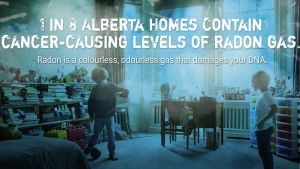February 9, 2019
Understanding Behavioural Environmental Design Contributors of High Radon Exposure to Protect Canadian Health

2017-2018 Annual Report Highlight
Radon is the second leading cause of lung cancer— after smoking— and the invisible, odorless, radioactive gas may be lurking in your home. AREF is supporting Evict Radon, an awareness campaign that encourages homeowners across the province to test their houses for radon gas while also providing data for researchers who are looking for a solution.
“We want to educate people about the effects of radon gas and encourage as many Albertans as possible to test their homes while also gathering data for medical research,” says Dr. Aaron Goodarzi, an assistant professor at the Cumming School of Medicine at the University of Calgary and lead of the Western Canadian Prairie Radon Study.
Radon occurs naturally when radium in the soil and rock breaks down. Goodarzi and his team have detailed radon gas analysis from more than 11,000 homes across Alberta and Saskatchewan. They found a staggering one in six houses contain hazardous levels of radon.
“We now have radon readings from all across Alberta and other parts of the prairies,” says Goodarzi. “We know that homes with higher square footage have higher radon. However, there are still several unknown home metrics that are contributing to high radon.” They’re trying to determine the “X factor” about why newer houses have higher radon than older houses.
The researchers are aiming to test more homes in Edmonton, Lethbridge, Red Deer and Medicine Hat and rural parts of Alberta. The best time to test for radon is during the winter. “That’s when we spend more time inside, and due to the cold, our homes are sealed up tight — the perfect conditions for radon exposure,” says Goodarzi.
People order a $60 Evict Radon test kit at evictradon.ca. They put the device in the lowest level of their home where they spend more than four hours a day and leave it there for at least 90 days. They register their device online, enter the start and end dates and fill out a short home metric survey. After the 90 days are up, the homeowner sends their device to the lab for analysis. They’ll get their radon level within a few weeks.
Radon occurs in areas all across the country. It’s the primary cause of lung cancer diagnosis in 10,000 to 40,000 Canadians every decade. And every day, an Albertan is diagnosed with radon-induced lung cancer despite never having used tobacco.
…
Read the Alberta Real Estate Foundation’s full 2017-2018 Annual Report.


